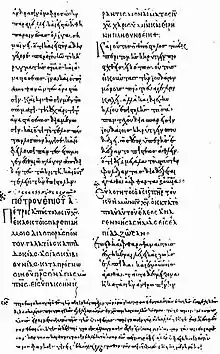| New Testament manuscript | |
 Beginning of 1 Peter | |
| Name | Mosquensis I |
|---|---|
| Sign | Kap |
| Text | Catholic epistles, Pauline epistles |
| Date | 9th century |
| Script | Greek |
| Now at | State Historical Museum |
| Size | 33.8 cm by 24.2 cm |
| Type | Byzantine text-type |
| Category | V |
| Note | close to 0151 |
Codex Mosquensis I designated by Kap or 018 (in the Gregory-Aland numbering), Απρ1 (Soden), is a Greek uncial manuscript of New Testament, palaeographically it has been assigned to the 9th century.[1] The manuscript is lacunose.
Description
The manuscript contains an almost complete text of the Catholic and Pauline epistles, with the exception of two lacunae (Romans 10:18—1 Corinthians 6:13; 1 Corinthians 8:8-11). Formerly it also contained the Acts of the Apostles, which book has been lost.[2]
The text is written on 288 parchment leaves (33.8 cm by 24.2 cm), in 2 columns per page, 27 lines per page,[1] in uncial script, but separated into paragraphs by comments, written in minuscule script.[3] There are some scholia at the foot of the pages attributed to John Chrysostom.[3] It contains breathings and accents.[2]
Text
The Greek text of this codex is a representative of the Byzantine text-type. Kurt Aland placed it in Category V.[1] Textually it is close to Uncial 0151.[4]
In Romans 1:8 it has variant περι, along with the codices א A B C D* 33 81 1506 1739 1881, against υπερ — Dc G Ψ Byz.[5]
In Romans 8:1 it reads Ιησου κατα σαρκα περιπατουσιν αλλα κατα πνευμα, for Ιησου. The reading of the manuscript is supported by אc, Dc, P, 33, 88, 104, 181, 326, 330, (436 omit μη), 456, 614, 630, 1241, 1877, 1962, 1984, 1985, 2492, 2495, Byz, Lect.[6]
In 1 Timothy 3:16 it has textual variant θεός ἐφανερώθη (God manifested) (Sinaiticuse, A2, C2, Dc, K, L, P, Ψ, 81, 104, 181, 326, 330, 436, 451, 614, 629, 630, 1241, 1739, 1877, 1881, 1962, 1984, 1985, 2492, 2495, Byz, Lect), against ὃς ἐφανερώθη (he was manifested) supported by Sinaiticus, Codex Alexandrinus, Ephraemi, Boernerianus, 33, 365, 442, 2127, ℓ 599.[7][8]
In 1 Peter 4:14, the manuscript contains the variant reading κατὰ μὲν αὐτοὺς βλασφημεῖται, κατὰ δὲ ὑμᾶς δοξάζεται ("according to them he is blasphemed, but according to you he is glorified") along with manuscripts L P Ψ 1448 1611, the Byzantine Codices, a majority or all of the Old Latin witnesses, the Wordsworth/White Vulgate Edition, the Greek-manuscript-consulted Harklensis Syriac Vorlage, Sahidic manuscripts, one Bohairic manuscript, and the church father Cyprian (3rd Century).
History
The manuscript is dated by the INTF to the 9th century.[1][9]
The manuscript came from the Dionysiou monastery at Athos to Moscow in 1655.[2][10]
It was examined by Scholz and collated by Matthaei. Cited in all editions since Tischendorf's edition.
The codex came from Athos to Moscow, where is located now in the State Historical Museum (V. 93).[1][9]
See also
References
- 1 2 3 4 5 Aland, Kurt; Aland, Barbara (1995). The Text of the New Testament: An Introduction to the Critical Editions and to the Theory and Practice of Modern Textual Criticism. Erroll F. Rhodes (trans.). Grand Rapids: William B. Eerdmans Publishing Company. p. 113. ISBN 978-0-8028-4098-1.
- 1 2 3 Gregory, Caspar René (1900). Textkritik des Neuen Testaments [Textual criticism of the New Testament] (in German). Vol. 1. Leipzig: J.C. Hinrichs’sche Buchhandlung. pp. 101–102. Retrieved 8 December 2018.
- 1 2 Bruce M. Metzger, Bart D. Ehrman, "The Text of the New Testament: Its Transmission, Corruption and Restoration", Oxford University Press, New York - Oxford 2005, p. 77.
- ↑ Codex Mosquensis I Kap (018): at the Encyclopedia of Textual Criticism
- ↑ NA26, p. 409
- ↑ UBS3, p. 548.
- ↑ Bruce M. Metzger, A Textual Commentary on the Greek New Testament (Deutsche Bibelgesellschaft: Stuttgart 2001), pp. 573-573.
- ↑ 1 Timothy 3:16 in Codex Alexandrinus at the Bible Research
- 1 2 "Liste Handschriften". Münster: Institute for New Testament Textual Research. Retrieved 16 March 2013.
- ↑ Frederic G. Kenyon, "Handbook to the Textual Criticism of the New Testament", London2, 1912, pp. 107-108.
Further reading
- C. F. Matthaei, Novum Testamentum Graece et Latine (Riga, 1782-1788). (as g)
- A. Diller, A Companion to the Uspenskij Gospels, in: ByZ 49 (1956), pp. 332–335;
- J. Leroy, "Un témoin ancien des petits catéchèses de Théodore Studite", Scriptorium 15 (1961), pp. 36–60.
- Kurt Treu, Die Griechischen Handschriften des Neuen Testaments in der UdSSR; eine systematische Auswertung des Texthandschriften in Leningrad, Moskau, Kiev, Odessa, Tbilisi und Erevan, T & U 91 (Berlin, 1966), pp. 280–283.
External links
- Codex Mosquensis I Kap (018): at the Encyclopedia of Textual Criticism
- Image from Codex Mosquensis